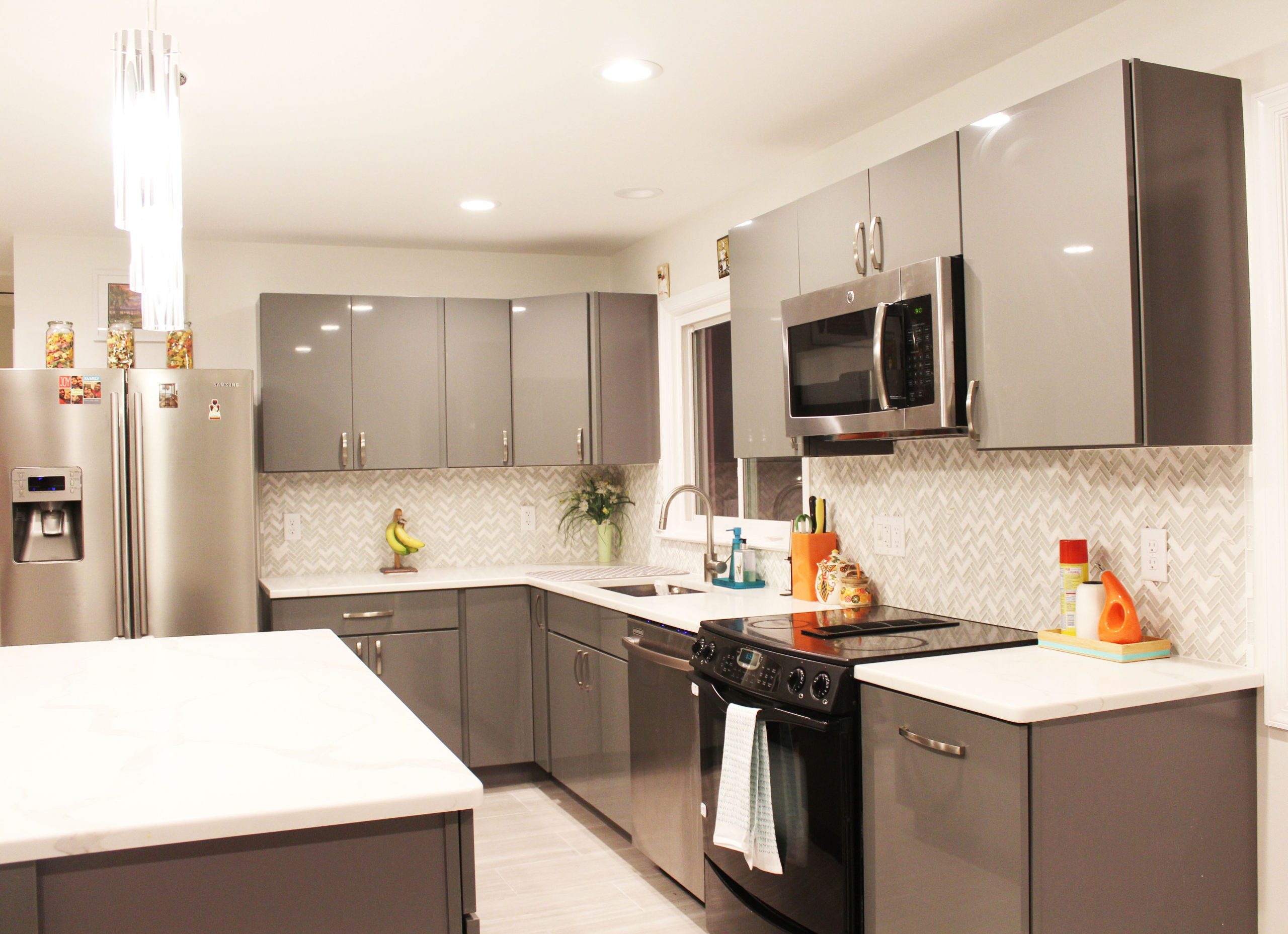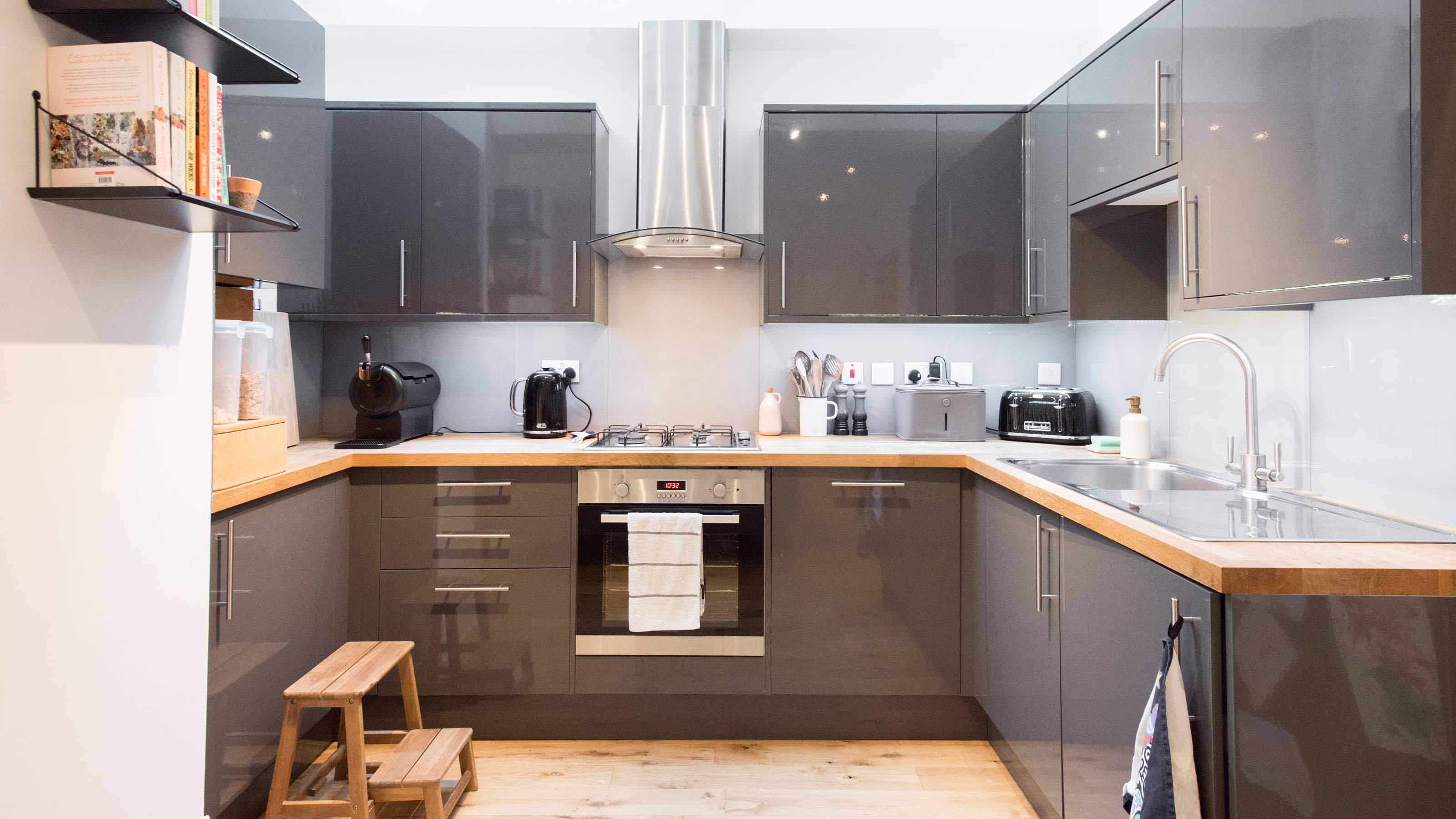High Gloss Paint Properties and Application

High-gloss paint offers a dramatic, sophisticated finish for kitchen cabinets, transforming the heart of your home. Its reflective surface not only enhances the beauty of your cabinetry but also provides practical advantages in terms of durability and ease of cleaning. However, achieving a flawless high-gloss finish requires careful preparation and precise application techniques. This section delves into the properties of high-gloss paint, provides a step-by-step application guide, compares oil-based and water-based options, and offers a comparative analysis of leading brands.
High-Gloss Paint Characteristics
High-gloss paint for kitchen cabinets is characterized by its exceptional sheen, typically exceeding 75% gloss. This high level of reflectivity creates a sleek, modern aesthetic. Beyond aesthetics, high-gloss paints are formulated for superior durability, resisting scratches and chipping better than lower-sheen alternatives. Their smooth, non-porous surface is incredibly easy to clean, making them ideal for the high-traffic, often-spilled environment of a kitchen. The inherent hardness of high-gloss paint provides significant protection against everyday wear and tear.
Applying High-Gloss Paint to Kitchen Cabinets, High gloss paint for kitchen cabinets
Achieving a professional-looking finish requires meticulous preparation. First, thoroughly clean the cabinets to remove grease, grime, and any existing coatings. Sanding with fine-grit sandpaper will smooth the surface and improve paint adhesion. Any imperfections, such as dents or scratches, should be filled with wood filler and sanded smooth. Applying a high-quality primer is crucial, particularly with darker colors or if covering existing stains. A good primer will ensure even color distribution and enhance the final finish. Apply thin, even coats of high-gloss paint, allowing ample drying time between each coat (usually 2-4 hours depending on the paint type and environmental conditions). Use a high-quality brush or roller designed for smooth finishes, avoiding brushstrokes as much as possible. Multiple thin coats are preferable to one thick coat, which can lead to drips and uneven coverage.
Oil-Based vs. Water-Based High-Gloss Paints
Oil-based high-gloss paints offer exceptional durability and a very hard, resistant finish. However, they have a strong odor, require mineral spirits for cleanup, and have a longer drying time. Water-based high-gloss paints, on the other hand, are low-odor, clean up easily with soap and water, and have a faster drying time. While water-based paints are generally less durable than oil-based options, advancements in formulation have significantly reduced this gap. The choice depends on individual preferences and priorities; if durability is paramount and odor is less of a concern, oil-based is a strong contender. If convenience and low odor are priorities, a high-quality water-based option is a suitable choice.
Comparison of High-Gloss Kitchen Cabinet Paint Brands
Choosing the right paint can significantly impact the final outcome. The following table compares four popular brands, considering price, coverage, and drying time. These values are approximate and can vary depending on the specific color and application method.
| Brand | Price (per gallon) | Coverage (sq ft/gallon) | Drying Time (per coat) |
|---|---|---|---|
| Benjamin Moore Advance | $70-$90 | 350-400 | 2-4 hours |
| Sherwin-Williams Emerald Urethane | $65-$85 | 300-350 | 2-3 hours |
| Farrow & Ball Full Gloss | $100-$120 | 300-350 | 4-6 hours |
| KILZ Premium High Gloss Enamel | $40-$60 | 300-350 | 1-2 hours |
Color Selection and Design Considerations: High Gloss Paint For Kitchen Cabinets

Choosing the right color for your high-gloss kitchen cabinets is a crucial design decision. The reflective nature of high-gloss paint amplifies the color’s impact, significantly influencing the overall mood and feel of your kitchen. Careful consideration of color trends, light reflection, and complementary elements will ensure a cohesive and stylish space.
Popular High-Gloss Kitchen Cabinet Colors and Their Effects
High-gloss finishes lend themselves beautifully to a variety of colors, each offering a unique aesthetic. Currently, several shades are particularly popular, each impacting the kitchen’s ambiance in distinct ways.
- Classic White: A timeless choice, classic white high-gloss cabinets create a bright, airy, and spacious feel. The high-gloss finish enhances the sense of cleanliness and modernity. Complementary colors include warm wood tones for countertops, a subtle grey backsplash, or even pops of bold color through accessories. Imagine a kitchen bathed in natural light, the white cabinets reflecting the sunbeams, creating a cheerful and inviting atmosphere.
- Deep Navy Blue: A sophisticated and dramatic option, deep navy blue high-gloss cabinets add a touch of luxury and elegance. This color works well in larger kitchens where it won’t feel overwhelming. Complementary colors include light-colored countertops like marble or quartz, and a backsplash with metallic accents like gold or brass. Picture a kitchen with a deep navy blue island, the gloss reflecting the warm glow of pendant lighting, creating a sophisticated and inviting space.
- Soft Greige: A versatile neutral, soft greige (a blend of grey and beige) high-gloss cabinets offer a calming and understated elegance. It’s a great option for those who want a neutral palette without the starkness of white. Complementary colors include warm wood tones, a light-colored backsplash, or even subtle patterns. Envision a kitchen where the soft greige cabinets blend seamlessly with natural light, creating a tranquil and harmonious environment.
- Muted Green: A calming and refreshing choice, muted green high-gloss cabinets bring a touch of nature indoors. This color works well with both modern and traditional kitchen styles. Complementary colors include light wood tones for countertops, a white or cream backsplash, and natural materials like rattan or bamboo for accessories. Imagine a kitchen where the muted green cabinets complement the fresh greenery outside the window, creating a peaceful and rejuvenating atmosphere.
Impact of Light Reflection on High-Gloss Paint Colors
The reflective quality of high-gloss paint significantly alters how colors appear in a kitchen. Darker colors absorb more light, creating a more intimate and dramatic atmosphere, while lighter colors reflect more light, making the space feel larger and brighter. The direction and intensity of natural light also play a role; north-facing kitchens might benefit from warmer tones to compensate for less sunlight, while south-facing kitchens might tolerate cooler tones. Consider the existing light sources and their impact on the chosen color to achieve the desired effect. For instance, a deep emerald green might appear almost black in low light, while a pale yellow might seem almost white in bright sunlight.
High-Gloss Kitchen Cabinet Color Schemes
The following examples demonstrate how high-gloss paint can be used to create distinct kitchen styles.
- Scheme 1: Modern Minimalist: High-gloss white cabinets, white quartz countertops, and a simple white subway tile backsplash. This scheme maximizes light and creates a clean, uncluttered look. The high-gloss finish adds a touch of sophistication to the minimalist aesthetic.
- Scheme 2: Rustic Farmhouse Chic: High-gloss soft greige cabinets, butcher block countertops, and a whitewashed brick backsplash. This combination balances modern elegance with rustic charm. The high-gloss finish provides a touch of contemporary sophistication to the overall rustic theme.
- Scheme 3: Glamorous Contemporary: High-gloss deep navy blue cabinets, white marble countertops, and a gold-toned metallic backsplash. This scheme exudes luxury and drama. The high-gloss finish amplifies the richness of the navy blue, creating a striking focal point.
Maintenance and Care of High-Gloss Painted Cabinets

High-gloss kitchen cabinets, with their sleek and modern aesthetic, demand a level of care that ensures their enduring beauty. Proper maintenance not only preserves their pristine appearance but also extends their lifespan, protecting your investment. Understanding the specific needs of this finish is key to preventing damage and maintaining that showroom shine.
Cleaning High-Gloss Painted Cabinets
Regular cleaning is paramount to preventing dirt and grime from dulling the high-gloss finish. A gentle approach is crucial; harsh chemicals and abrasive cleaners can easily scratch the surface. For everyday cleaning, a soft microfiber cloth dampened with warm soapy water is ideal. Always wring out excess water to prevent moisture from seeping beneath the paint. After washing, immediately buff the cabinets dry with a clean, dry microfiber cloth to restore their shine. For stubborn stains, a mild dish soap solution can be used, followed by thorough rinsing and drying. Avoid using abrasive sponges or scouring pads, which can mar the surface.
Addressing Common Problems
Several issues can affect high-gloss painted cabinets. Water rings, for example, can appear from condensation or spills. These are often easily removed with a gentle cleaning solution and thorough drying. Fingerprints, a common occurrence in high-traffic areas, can be quickly wiped away with a damp cloth. More serious problems, like chipping or scratching, require specific repair techniques. However, preventing these issues through careful handling and regular cleaning is always the best approach. For instance, regularly polishing the cabinets with a high-quality furniture polish designed for painted surfaces can help to repel dust and fingerprints, making cleaning easier.
Repairing Minor Scratches and Chips
Minor scratches can often be buffed out with a fine-grit automotive rubbing compound applied with a soft cloth, followed by polishing with a high-quality furniture polish. For deeper scratches or chips, a touch-up paint matching the original cabinet color is necessary. Apply the touch-up paint sparingly, using a fine-tipped brush or toothpick, and allow it to dry completely before gently sanding and polishing the area to blend it seamlessly with the surrounding surface. For larger repairs, consider consulting a professional painter experienced in high-gloss finishes. Remember, a small amount of touch-up paint applied carefully is far better than a large, uneven application. Using a high-quality touch-up paint designed specifically for your type of cabinet finish is essential for color matching and durability.
